Nature Unveiled - Flight In Birds "And I Peeked In The Sacred Books"
Just like I promised you guys in my introductory article, my articles will span across my interests and for the first time I decided to take a quick stroll through nature works, guess what, I discovered quite a lot. It was actually a quick stroll but don't mind the content length, this guy called nature is quite voluminous to study.
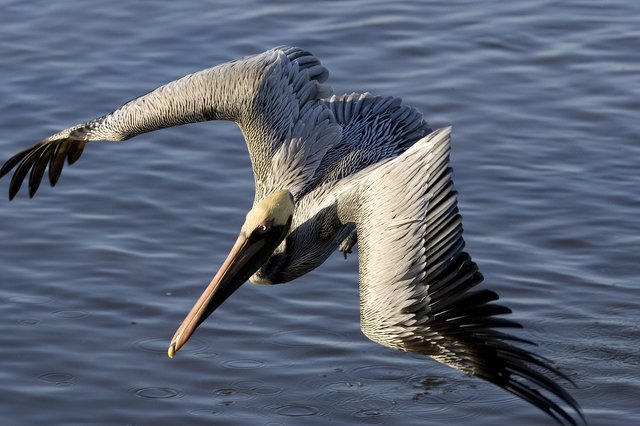
Source : Pixabay
Have you heard someone the works of nature can never be understood or be like it's all magical, though nature's works are sometimes hard to understand but here with me on Steemit you now have the ability to take a peek into that sacred books of nature as we Unveil its works, and guess what I picked out through a peek into this great book, Flight in birds.
So join me as we study the science of flight in birds
Flight
Flight simply entails the ability to move in the atmosphere, this can be brought to play by balancing forces in the air. Majority of birds fly but some are flightless or take dives in the sea. Since The birds are the natural animals, we will take a look at how the come about this, traits which supports this and some behaviors during flight, I promise this to be fun and quite educating, so stick with me as we Unveil Nature.
The A Major Flight Element
Majority of members of bird species have their major movement to be by flight and nature so made them for this, flight birds possess different physical characters which tend to keep them in air during flight these traits evolve in birds with time helping them become better at this, for a bird to fly, below are some traits possessed :
THE WING : the wings of a bird comprises of its forelimb bones which are, the ulna, humerus and the radius. The bird wings is known to be a major needed trait for flight hence a part of this article will focus more on the bird wing,
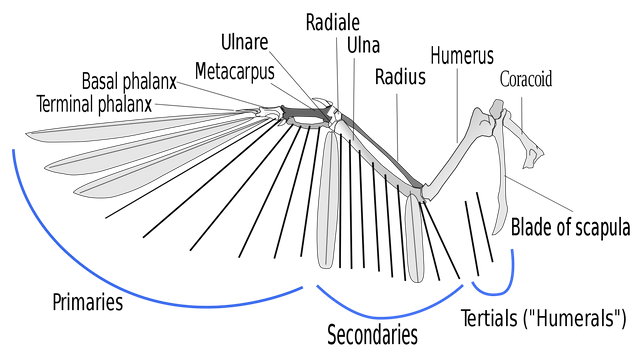
Wiki Common : Bones Of The Wing Of A Bird By L. Shyamal Is Licensed Under CC-BY-SA 2.5
but is the Wing the only needed trait for flight? , we see some birds termed flightless birds with wings but find it difficult to soar the air, here is another trait for flight
FEATHERS : The feathers of these birds are in form of vanes, they possess hooklets which tend to zip the vanes together hence a way to counter the force of the air leading to force for flights, the hooklet between these vanes also helps in maintaining the shape of its feathers.
When a single feather was studied, it was noticed that the feather of a bird has a major side and minor side, the major side is quite greater than the minor side, which implies that the shaft of a feather do not run through the middle.
During flight there is rotation of this feather with regards to its follicle, in an upward movement of the Wing, the greater part of the feather points downward allowing air to pass so as to allow wing move easily upwards and on a downward wing movement they come back to original position thus causing lift in birds.
BODY STRUCTURE AND WEIGHT: The body of a bird is an important factor which determine it's ability to fly. Birds that soar the air have their bodies streamlined which help them overcome air drag during flight, their body weight is less as their skeletal system is of a reduced weight with respect to other animals.

The largest living heaviest flying bird on earth is the Kori Bustard having weight about 18kg for its male whereas female weigh half the size.
Also...
The tallest bird to walk the earth is the is the Giant Moa, this bird(now extinct).

RESPIRATORY SYSTEM : Evolution have led to the unidirectional pulmonary system in birds which allows for high oxygen for their respiratory system hence providing the needed energy to fly.
And The Flight Begins- Taking Off
To begin flight, these birds must find a way to get in to the air which is quite a demanding task. Take off requires some amount of energy, they must with their wings generate enough energy to bring the lift force in play.
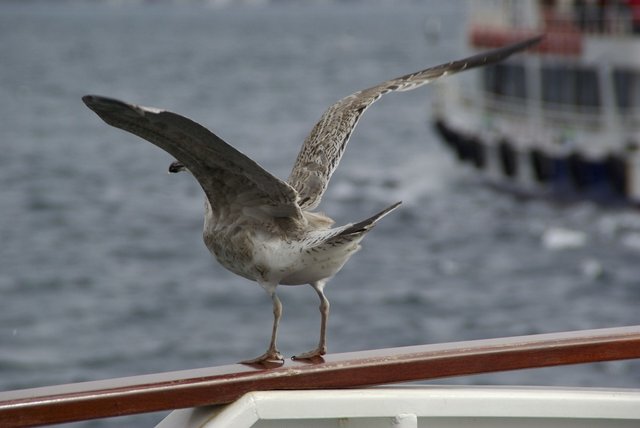
Pxhere:An easy take off of birds is the free fall from a height take off
For small birds, this can be as easy as an upward jump while for larger ones, a run might be needed to bring required airflow, they also put the movement of the wind into consideration hence running, facing the direction of the wind. To not pass through this, they tend to perch on a cliff or branch so as to easily take a drop into the air to begin flight.
The Wing Shape And How It Affects Flight
Have you ever asked why some birds have the ability to fly at a higher altitude while others don't, or why some birds move at a fast speed and others can't, let's understand why some birds posses some flight capabilities while others don't.

Wikimedia commons : Bird Flight By L. Shyamal Licensed under CC-BY-SA-2.5
The wing of a bird play an important role in flying but the shape of the wing tend to give the birds some traits while flying, the different shapes of wing corresponds to capabilities like the use of energy, speed and it's ability to maneuver during flight. Considering how wing modulation affect the flight of a bird, two parameters are to be put into consideration, they are the wing aspect ratio and the wing loading.
The Wing Aspect Ratio simply entails the ratio of the wing span to its cord. Understanding aspect ratio, the length of the wing and it's width comes to play, it is said to be the span of the wing divided by its area, which implies that a long and narrow wing has a high aspect ratio than a short and wide wing, stick with me, we shall discuss how the aspect ratio affect flight.
The bird is also affected by its Wing Load , you definitely have come across some birds finding it difficult to fly due to their large weight with respect to wings, then you will definitely agree with me if I say the weight of the bird with respect to its area affects a bird flight capability.
Grouping According To The Shape Of Their Wing
All birds of our planet can be grouped with respect to their wing shape in four groups, don't get worked up if you see a bird fall in two group as some might possess traits to classify them in that group, these groups are:
Birds With Elliptical Wings
These are wings are of a low aspect ratio, they have a rounded shape and they are quite short with respect to length. This wing allows them to easily maneuver through confined spaces such as those found in tight vegetation, hence, these birds are found mostly in forest areas. Example of an Elliptical wing bird is the Accipiter Hawks, also birds like the partridges and the peasant which use the rapid take off system to evade predators also fall into this class.
Birds With High Speed Wings
Some birds are built for the speed, with quite a wing that suit the speed flight system, these birds have their wings short and pointed and can achieve high speed when combined with a rapid Wing-beat technique, also they have quite a dense wing loading, producing an energetic and fast speed.

The highest recorded speed is known to the peregrine Falcon with a dive speed of 242m/s
Also ...
105 m/s is known to be the fastest straight flight for a bird with the spine-tailed swift bird recording this.

Some birds with this wing shape are the peregrine Falcon and some ducks, this shape of wing is also found in the auks but aside for flight on air, the auks use this to achieve its speed under water.
Birds With High Aspect Ratio
These are birds which fly at a low speed, their shape of wing are known for low wing loading and a high aspect ratio. They have their flight system in form of gliding, hovering and soaring, the hovering flight system can be attributed to birds like the nightjars kestrel and the terns and the soaring linked to the seabirds as they tend to depend on my the wind speed with respect to altitude to fly.
Nature designed birds which hunt for fish with this wing geometry as it is needed to plunge dive when hunting for fish at sea.
Wings For Soaring (They Posses Deep Slots)
This is the wing type seen for inland birds, they have slots at ends of their wings which helps bring to captivity the energy of the air to the upper surface of the wing helping them to have low drag. The shorter part of their wing is used for take off
Types Of Flight Pattern In Birds
Just like you might have noticed looking at birds fly, they all do not have the same flight pattern, in this part of this article, we will look at the different ways birds fly.
The Flapping Flight
During flight, some birds are noticed to continually flap their wings, hence the term, the Flapping flight. This flight involves the upwards and downwards movement of the wings to keep the balance of forces in the air.
When observed, sections of their wings play some important role to sustain this flight, the part close to the body tend to move less with regards to the upward and downward movement which provides the lift force for flight while the distal part tend to form a wide arc generating thrust for flight (more on this below, see forces of flight) .
The downward stroke is also known as the power stroke. Here, the wings move downward and in a forward direction, the leading edge of the wing which is the frontal part is lower while the trailing edge follows, producing a forward thrust to the bird. The upward stroke is known as the recovery stroke, (but in some birds, this provides a little thrust), this sees the wings a bit folded inward and slots, if possessed, opens to allow for the passage of air reducing the energy costs of the upward stroke.
Some of the Flapping flight specie exhibit intermittent patterns where they combine several type of flight patterns.
The Gliding Flight
This is another flight technique used by birds, gliding flight mode simply implies a significant horizontal travel in a distance without direction vertical change. Gliding, the the weight of the bird is equal to the upward force, no propulsion is needed in this form of flight and energy loss by the bird comes in form of drag which results a potential energy which tend to form a decending flight pattern.
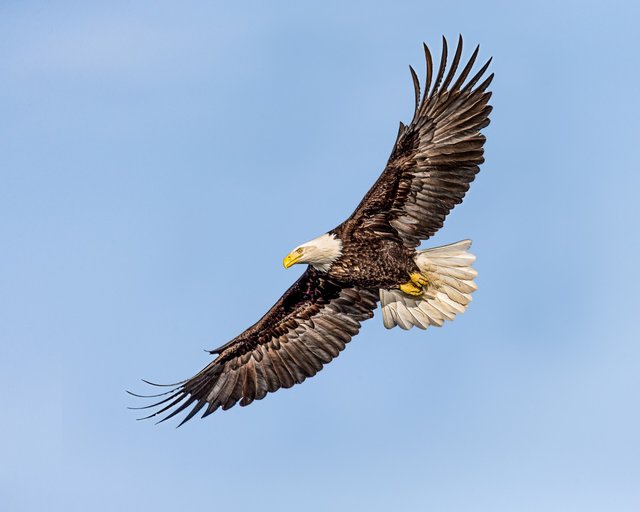
Source: pxhere, The eagel, a known gliding bird
This is also termed soaring flight and it has been observed that bird which take such flight do this as a result of the present atmospheric condition. The soaring flight tend to lead to less loss in energy of flight and increased efficiency.
Some birds which use this flight pattern are, the Vultures, the Eagle, Condor, The Frigatebird and more.
The Bounding Flight
Yet another fight pattern and this time it is termed the bounding flight. This is is normally exhibited by some small birds and it involves a series of short burst flapping which is followed by founding their wings against their body for some time.
Also know as flap-bounding, the trajectory of the bird wings are folded is ballistic way and a little of body lift occur. This flight pattern has been studied and confirmed a low energy flight and the aerodynamic drag is reduced when it's wings are folded, it also save energy which is used only when needed for flap their wings hence a simple flight system.
Hovering
Only few birds use this flight pattern, the hover pattern simply entails a staying In one place for some time and moving when needed. Birds like the American Kestrel and the Ospreys hover but the king of Hovering is know to be the hummingbirds, they are capable of remaining in one place for a very long time.
During Hovering, the hummingbird for example sets it's body at an angle of 45 degree moving it's wings in what looks like a pattern of figure 8. Their downward stroke is said to generate more force than its up stroke but it's lift is associated with two half stroke,
Hovering amongst birds is rear, and requires a lot of energy to achieve when compared to flight at high speed.

The only bird capable of making a backwards flight through a distance is the hummingbird, they use the hovering flight system and tend to beat their wings about 80 times in a minute which helps balance movement

Forces That Acts On A Bird During Flight
To remain steady in air, fly higher or at an increased speed, some forces come to play up there, some of these forces are;
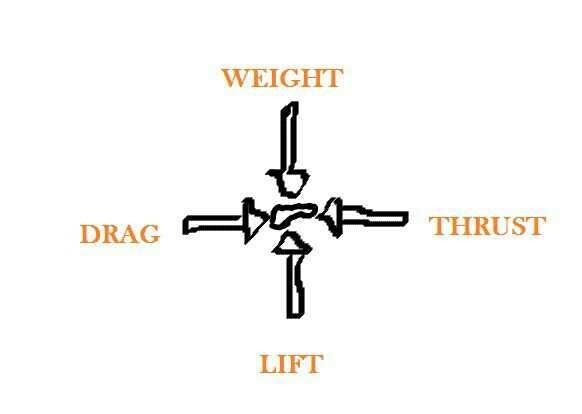
Forces Acting on A Flying Bird, *Image by Author using Microsoft Paint *
Thrust - The Quest To Move Forward
This is the force which tend to propel the bird in a forward direction, the excess or deficit of this force entail the acceleration or deceleration of the flying bird, hence as the thrust increases with respect to drag, speed is achieved, when thrust equals drag there is speed balance in the flight.
But if we may ask, how actually dose a bird develop thrust?
Unlike the airplane where the engine acts as a propeller for the plane, birds use their wing to develop this forward motion.
During flight, as a bird makes a downward wing beat, it's primary feathers tend to stand out at an angle almost equaling 90 degrees to the other part of the Wing, this twist occurs for a split second but this split second gives the needed forward motion.
The oscillating wings of the bird change position in a way to continually produce thrust, when in a slow flight mood, only the Wing tips maintain this force but during a fast flight or when about to take off all parts of the Wing come to play to produce the thrust force.
Drag Force - The Opposing Force Of Air
Any propulsion through air will experience a kind of resistive force, this force is known as the drag force and it is with respect to different physical phenomena. In air it is termed pressure drag which is needed to be overcome to move in air.
This force is opposite the direction of motion hence opposite the thrust force. Drag during flight can be of two forms, one of which is the lift induced drag. This drag is experienced when the bird tend to experience lift during flight. Another form is the parasitic drag force which is as a result of friction between air and the bird, such as its frontal area, body streamline and wings.
Lift - The Quest To Move Upwards
To experience a rise in the air, the concept of of the lift force comes to play. In any form of flight, lift is formed when air flows past an airfoil, the shape of this foil makes this flowing air to be more faster at the top of the airfoil than its bottom, this decrease the air pressure at the top and since a greater pressure is developed under the airfoil, the action of lift comes to play.

A bird with a large wing tend to produce more lift than another with a small wing, this varies speed, hence for a bird with a smaller wing to meet the speed of one with a larger wing, it must move it's wings more faster in air.

The wings of a bird is a good example of an airfoil, and the shape of this wing plays a major role in lift, a large wing tend to create a wider path for air to flow and this results to a more reduced air pressure. Furthermore, the angle of the Wing on flight also play a role in lift this angle position tend to cause a reaction force through an opposite direction hence bringing about lift.
Weight - The Downward Force Of Gravity
The weight force acting on a bird or any object on earth simply entails the gravitational pull on that body, this comes due to the body mass and the gravitational pull. The weight force acts directly opposite the lift force and as they fly, the balance between the weight an lift force tells the position of the flying body, this force tells if it will descend, stay in a horizontal position or go upwards.
When the weight and the lift force is at equilibrium, the flying body stays in an equilibrium position neither moving upward or downward, but when the lift is more than the weight, their is experienced an upward movement by the flying body.
Mathematically, the weight force is denoted below ;
Where g in the equation is the acceleration due to gravity
Have You Noticed Them Fly In A Formation?
Sometimes I imagine and ask questions like, how they actually know the formation to take when flying, how do they get to keep this formation and why they take this group flight, it's intriguing but I know you will like an answer to why birds fly in a formation , Let's hit the nail on this!!

Pexels: They tend to fly sometimes in a V-formation
Birds like cranes and geese have been observed to take the V formation during flight and they actually have a reason for that. During flight, the leading bird in front creates a vortex which is put to use by others hence experiencing an updraft which provides lift making an easier flight for trailing birds.

Flocking of birds is as a result of a number of social factors which include protection against predators, reproduction,navigation, communication, flight and lots more.
Also...
The highest number of bird Flocking is experienced in the Red Billed Quelea, this bird is known to flock in millions and take about 8 hours to fly overhead.

At the end of the wingtip, a vortex is formed which creates a down flow of air behind them, this vortex can be taken into use by another bird which would fly at a lateral position with respect to the bird in front, but not all birds benefit from flying in flock, take for example, the Pigeon, there is no gain flying on flock as this will lead to more flap hence more energy needed for stability in a packed cluster.
Landing - Done With The Flight? , Let's Bring It Down
Many birds have their landing pattern, in birds the concept of landing is difficult when compared to take off, this is due to the shock experienced to bring to stop the bird with respect to movement in air, if landing in birds is not done right, it might cause a kind of fusion of its bones.
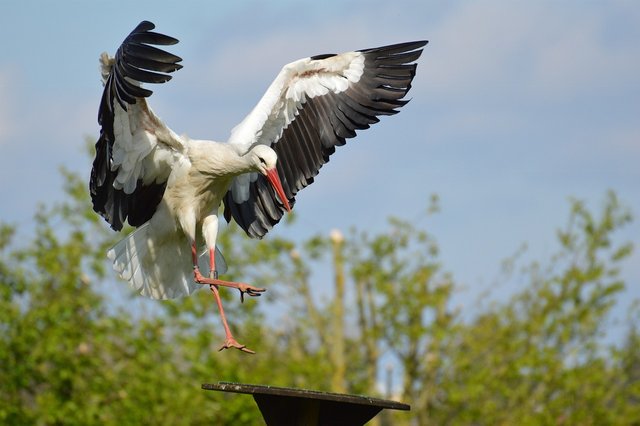
Pixabay, Alexax_Fotos : They tend to reduce momentum while landing and spreading of wings can help achieve that
Some birds tend to land in a vertical direction while others are seen to do so in an angle with respect to the Wind so as to bring about a slow motion before landing with their wings wide spread . Landing in some birds also take the form of running on the ground to bring to reduction in momentum of movement.
Birds like the woodpecker would land on trees , as a measure to reduce speed they would fly below an intend land site and go landing using the upswing style.
Bringing It All Together
It's been quite fun unveiling the flight of birds to you all, just like you have seen, many traits make the bird to stay on air both with respect to its body structure and the forces which tend to keep them up there, we will just wrap it all up by saying nature did quite an awesome job with respect to the birds.
** Want to see a Falcon Fly? Click play on the video below. **
Source : YouTube Licensed under Standard YouTube license
Early study of the flying birds gave humans an insight to build flying machines and today, humans can soar the air with these machines hence an easy travel when compared to road and rail transportation which is just awesome (Want to know men and their inventions, see Legends Of STEM- Archimedes Of Syracuse
Have it been fun learning? ☺, click on the follow button, care to let others know about birds and flight? There you go with the resteem button, and lastly, don't forget to say your piece in the comment section below, I really do want to meet you and your great contents 😀
REFERENCES
IMAGE, VIDEOS AND LINES
Images and videos are sourced just below them. Used images are free for reuse.
*Image of Forces in flight was created by author with Microsoft Paint Tool. *
Line reference Line 1: pixabay And Line 2: pixabay
TEXT SOURCES
The Flight Of Birds, Ornithology
FACTS
Facts are from the text sources above but additional facts was from 1, 2
** Until Next Time, Stay Cool 😎 **